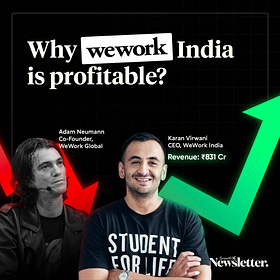Why Nestaway failed & how could it fix the problem?⚡️
Business deep dive into co-working Vs co-living.
Welcome to the 153rd edition of the GrowthX Newsletter. Every Tuesday & Thursday I write a piece on startups & business growth. Today’s piece is going to 95,300+ operators & leaders from startups like Google, Stripe, Swiggy, Razorpay, CRED & more
2019 → Nestaway raised $110 million in total 💰
2023 → It’s been sold at 95% discount 🤯
Here's why Nestaway failed, in simple language ⬇️
Quick context 🗓
Nestaway is a home rental marketplace. It’s primary business is letting out single / double occupancy rooms to bachelors. Think of it as a managed PG but inside a gated society - it has a cute name “co-living”.
The asset lite model 🪶
Nestaway does not own any of the properties that it manages. It has home owners on one side and tenants on the demand side. It onboards apartments on it’s platform and furnishes them before letting out.
The model worked ♥️
Home owners loved the low paperwork, higher rental yield and most importantly timely rental payment guarantee model. Bachelors finally got an option to split apartment rentals plus no owner "tussle” to get a bachelor friendly apartment.
Nestaway makes a sweet 15-22% margin from every monthly rental payment.
Things have gone south from 2019 📉
Nestaway has been sold to Aurum, a company that makes software for real estate businesses, in a fire sale of Rs 90 crore.
Interestingly, WeWork india, which operates in ‘co-working space’, posted a profit. It clocked 250% growth in earnings before interest, taxes, depreciation and amortisation (EBIDTA) registering ₹175 crore profit in 2022.
Why Nestaway failed to turn a profit? ⬇️
1/ The revenue share model is different 💸
WeWork allows businesses to lease its spaces by number of seats. It creates an arbitrage between what it pays for the space vs what it charges. Nestaway does exactly the opposite - it uses an asset lite model & shares revenue, limiting margins.
2/ The margins vs Cost makes little sense 🤐
Imagine a Nestaway tenant breaking a water tap inside the apartment. Nestaway policy covers it through the deposit amount. Imagine one such instance in a quarter and that 15% margin is eaten by ops expenses.
3/ Demand supply <> mismatch is expensive 🔥
Nestaway like product requires users who are ready to buy in for a longer term contract - it creates revenue predictability. But, it also creates a supply demand mismatch. Until they get a tenant for a property, the property makes no money.
Compare this with the WeWork model. Apart from the office leases that it does as the main business, it also sell hot desk passes, daily passes creating a steady flow of revenue walking in through the door, every freaking day.
4/ Lead → purchase journey is super short ⌛️
Think of the ideal customer Nestaway has - bachelors who take super short time to find a place relative to the WeWork customers which is typically a business owner who will take ~1 month to zero down on a property. It gives little time for Nestaway to capture & convert the lead.
5/ It’s cashflow intensive business ✨
It takes one tenant payment to get delayed payments to the house-owner. Add in eviction expenses when things go south with the tenant. It all adds up to having a large working capital for the business to function smoothly.
No wonder - Aurum, the company that bought Nestaway at ₹90 Cr, has infused ₹30 Crores as part of the deal to stabilise working capital requirements.
6/ Non-existent word of mouth 💔
Apart from the super early days of nestaway, it has destroyed customer trust over and over again - on both sides of the platform owners & tenants. Call it wafer margins, funding issues, missing nuance of demand supply and doing random rent guarantees to owners.
7/ What’s next for nestaway?
First, it has scaled down massively - and I strongly believe it’s the right move. It’s bleeding cash and this last ₹30 Cr is all Aurum is going to put in. That means it needs to get operationally profitable at a unit economics level for most properties.
How could Nestaway get out of the mess? 🛠
First, solve for cashflow “float” 💸
The current model does not give it any breathing space when things go south. Immediate step is to re-negotiate rental payment terms with owners. The cashflow needs to have breathing space between payment received from tenant and given to the owner. This will also create a liquid float for the business.
Second, rethink the customers they service 🕹
The bachelor ICPs with lower salary income levels have limited appetite to pay. Compare that to premium age bracket of 27 to 32 when most bachelors want to live in a good lifestyle. Positioning change will allow better pricing.
Third, solve for occupancy rates 🛌
And it starts with longer contracts (~11 months). Plus, building supply of apartments where demand is insanely high. Focus on penetrating there compared to expansion throughout city. Low occupancy is killing the model.
Fourth, do the win-win-win model 🔁
Until their tenants & owners are happy, this business is not going to make money nor scale. So solve for that first and then everything else. And yes, chuck this whole spend on marketing, you have got enough organic demand. Convert them better.
I am hopeful Nestaway will come out stronger.
Has it added value to the market? absolutely yes.
Is it perfect? Hello no. That’s all on this story for now.
I have been picky 🍒
About what products to work on, people to spend time with and the bets I take. This freedom has come from two important habits.
First, learning structures over instructions 🧠
I have never followed a process because I have been told to. The habit of understanding “The why” behind every task/action/ goal has led me to go deeper into understanding the right levers to problems, and eventually solve them.
Second, spending time with right social circle 🎳
And not over a glass of beer but in a group conversation where I am spending time with them solving/ understanding a problem statement.
After doing these 10s of times, we started GrowthX.
It’s the lifestyle that I had access to for a really long time before we built the full experience for over 2,100 members of the community full of deeper bonds. Did you know 65% of GrowthX’s first venture round came from the community?
I want you to have the privilege.
Take the bet, change your career orbit.
Thank you for supporting this newsletter 🪄
We spend a sizable portion of our time writing pieces for this newsletter. Share it with your closed circle / Twitter if you find it interesting.
If you liked today’s article, you’ll love this 💙
How is WeWork India profitable?💰
Welcome to the 196th edition of the GrowthX Newsletter. Every Tuesday & Thursday I write a piece on startups & business growth. Today’s piece is going to 94,400+ operators & leaders from startups like Google, Stripe, Swiggy, Razorpay, CRED & more








Great analysis Abhishek. But there are many other platforms working in the similar space like magicbricks, nobroker etc.. how did nestaway differ from them? What are some of the things these companies are doing which Nestaway did not do?
One thing I definitely can say is NestAway did not maintain transparent partner relations with the property owners, the staff kept changing and owners were absolutely clueless about what was happening with their property. I can say this based on my own experience as a property owner
Not sure If we should agree with this analysis.
Failure is an orphan and with hindsight it appears how the ship was always sinking. Saw closely how the short / long rental product of OYO shaped up so I think the reasons for Nestaway failure are a little different. Why I think so.
[1] The fixed rental full stack model is never asset light
- You correctly mention that Nestaway did not own the property (nor does WeWork with long leases) but like WeWork they did start with fixed rentals and doing so were free to upsell the inventory at any price like WeWork. The gross margins with with such models are definitely higher and not 15% - 20% as you claim. Note: Nestaway moved to the commission / revenue share model post COVID
- Nestaway / OYO and few others followed exactly the model that WeWork has where the supply and its price is fixed and then charges the user on demand, creating an elastic price
- Like WeWork or OYO, even Nestaway would have been successful in operating the full stack model for a longer time if not for CoVID or with a larger cash chest like the other two had
[2] Margin vs cost
- Material costs and depreciation have negligible effect on margins in such businesses. This could be clear if you look at their FS. Second they are easily secured with deposits so a 'broken tap' will not erode margins
- Rental products have strong local network effects. The problem is as much for WeWork as is for NestAway. You compete with local players on strong recall and a uniquely distinguishable/ standardised offering. Nestaway team just failed to deliver on the standardisation or did not focus long enough.
- Minimum Guarantees or fixed rents erode margins faster than any other head. This model is harder to execute for a short stay / rental product like OYO where you are almost selling every RN (room night) every day vs WeWork / Nestaway.
[3] Cash Flow intensive
- The only problem with full stack rental play is that every single room -> property -> cluster is your product that you plan to monetise. OYO championed the local CEO model for this to run a local P&L because the product is local. Cost of competition is difficult to bake in any business, harder if you compete local.
- WeWork and likes run negative P&Ls for almost all new locations. The nature of the business is that it expects you to invest in every local listing, that does not make it unworkable.
- The problem is poor execution. Their revenue went from 43cr in 2018 to 53 cr in 2019 and then to 90 cr in 2021. Changing to the fixed commission model did bring this down to 58cr which was expected. The revenue numbers are certainly not underwhelming.
This is indeed a capex first business with strong local effects. Very similar to WeWork. Why WeWork was able to turn it around and not Nestaway is just a function of capital and (founder) execution.